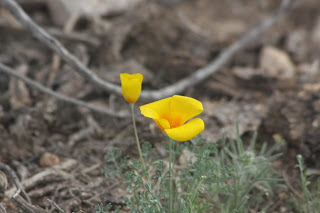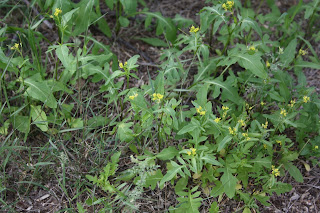So here goes some pictures of some of the more common blooms we have seen in the last couple of weeks.
The Mexican Gold Poppy is starting to pop up everywhere and can literally cover whole hillsides in magnificent yellow when it reaches its peak.
The brittlebush also has bright yellow daisy like flowers.
Smaller but still yellow is the common London Rocket.
Unfortunately it is an invasive non- native species and is not loved by the naturalists we have talked to in the Canyon.
More of a native and also small is the Fiddleneck with its hairy stems, leaves, and tiny yellow flowers that will bend over in maturity to look like miniature fiddles.
White is standout color in the desert. So far we have tagged the Desert Chicory.

The desert zinnia is also big enough to see from a distance.

Fleabane is more delicate, but is still fairly easy to spot.

The tiny Crypthantha takes a bit of looking for underneath nurse trees or shrubs. It's a "borage" like the Fiddleneck.


We've also seen a few nice stands of Rattlesnake-Weed. The redish stems here hold multiple tiny cup like flowers with deep red centers. Not sure why the rattlesnake name. Perhaps the snakes like to crawl under this low down bush.
A final more delicate white flower is on the Big Root or Wild Cucumber. At least we think that is what it is.
Blue is a nice color as well and in the past two weeks we have seen more and more of the elegant Blue Dicks poking up on their long slender stems
This one has even attracted an early pollinator.
Don't get them confused with the lovely Desert Lupin which does not have a long slender stem. .
The Lupin also has a signature star shaped leaf that is a perfect identifier.

The Caliche Globe Mallow takes us into the red or orange color palette.
And let's finish the abundant and beautiful Fairy Duster
The first stage of their bloom is a five pointed star.
As they mature they simply explode into a wispy cottony ball.






















No comments:
Post a Comment